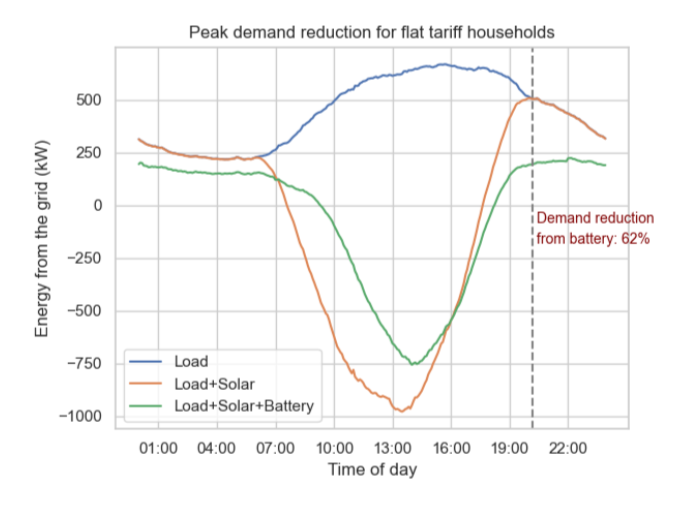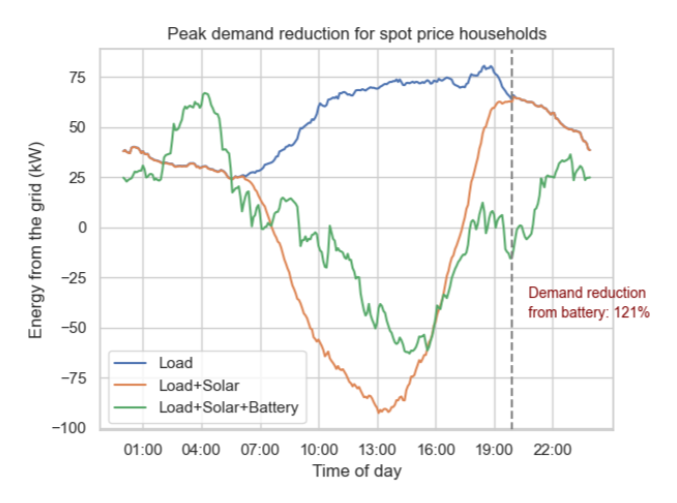There’s an El Niño summer on the way, and along with increased risk of bushfires and droughts, this means extra challenges for the Australian power grid. In all states except Tasmania, summer is when the grid hits its highest level of electricity demand, driven by the power consumption of cooling systems on hot days. Given that levels of solar production are also higher during summer, this can mean a very steep ramp-up in demand in the late afternoon: at midday, demand is very low as exported rooftop solar feeds into the grid, but then solar generation tapers off while cooling systems are dealing with the hottest part of the day. The shape of the well-known “duck curve” graph illustrates this phenomenon.

Aggregate energy import/export from the grid on a typical January day for PV-connected NSW/ACT households in the Evergen fleet, discounting the effect of battery storage.
On the really hot days when the demand peak is at its highest after sundown, that’s when we are most likely to see reliability issues in the grid, with the risk that generation can’t keep up with demand. To avoid that, Evergen’s Principal VPP Solutions Engineer Stephen Pritchard describes two key strategies that can be used to transform the sudden ramp-up into a more gentle rise with a lower peak (sometimes described as “putting the duck to sleep”): reducing demand at peak times, and using battery storage to time-shift solar generation.
“Demand response” is the strategy of adjusting demand to reduce the amount of generation required at peak times. Traditionally this has involved asking large industrial consumers to limit their usage, but as the grid and electrical appliances get smarter, it’s becoming more feasible to reduce demand over a large number of consumers, with only a small impact on each. This works best with high-load appliances that can be remotely controlled such as electric vehicles, hot water systems and some air conditioners.
“Such appliances are also suitable because they are somewhat flexible – altering when they switch off and on can be done in such a way that there are benefits for the grid but negligible impact on the owner,” said Dr Pritchard.
With a large enough fleet controlled by a smart system such as Evergen’s Intelligent Control, a significant reduction in energy demand can be achieved by only small adjustments to individual appliances. “Individual householders would barely notice the temporary change in their usage and would also receive some financial benefit.”
Time-shifting solar generation with the use of battery storage can smooth the extremes of the demand curve in two ways: increasing demand by storing energy during the day when solar generation is at its highest (thus avoiding stability issues in the grid when demand is too low), and then feeding the stored energy back into the grid in the evening, providing additional energy to help to meet high demand.
Owners of electric vehicles can also help lower peak demand by ensuring they charge outside of peak periods, but until EVs have the ability to feed stored energy back into the grid, they can’t assist with providing power to meet demand. So-called “vehicle-to-home” or “vehicle-to-grid” EV chargers are still a few years away from widespread use in Australia.
Home batteries can contribute to both of these processes, and data from Evergen’s fleet shows how much of a difference they can make. In the charts below, Dr Pritchard has demonstrated how the residential batteries in Evergen’s fleet significantly smooth the demand curve for individual households throughout an average day. Batteries have a noticeable effect whether or not they are optimised by a price signal, but optimising against spot prices definitely increases their impact.

Aggregate hourly data from January 2022 for Evergen households with large batteries on flat tariffs, in NSW/ACT
In Evergen’s fleet, “unoptimised” residential batteries are batteries installed in households on a flat tariff. Unoptimised battery behaviour is simple: it charges as soon as excess solar is available, stops charging when full, and begins discharging when household net energy consumption exceeds what their rooftop solar is providing. In this chart, the blue line represents household energy consumption (what would have been imported from the grid if no PV or battery were available); the orange line represents combined load and PV (power that would have been imported/exported if no battery were available); and the green line indicates the amount that was actually imported and exported, with PV and battery working to generate and store power locally and export back to the grid whatever is not consumed. In this case, unoptimised batteries provided demand reduction services of approximately 62%. These batteries also reduce the depth of the daytime trough and reduce the rate at which demand must climb to meet the peak, creating a more gentle slope for the duck’s neck.

Aggregate hourly data from January 2022 for Evergen households with large batteries exposed to wholesale prices, in NSW/ACT
For batteries optimised by Intelligent Control against wholesale market spot prices, the impact is much greater – up to 121%.
“For customers on retail contracts offering exposure to the wholesale market, Evergen’s optimisation magnifies the benefit of batteries for the grid,” Dr Pritchard said. “With this price signal, Evergen will optimise by not just shifting solar to meet evening peak demand, but also at times actively discharging the battery to the grid in the evening to also mitigate the demand of other households, and doing so in a way that the owner is properly valued for this service.”
Of course there are also environmental benefits to reducing peak demand in the evening. While some renewable energy will still be in the mix at this time, such as wind and hydro, in most states evening demand will be supplied by coal-fired power and topped up with gas peaker plants. So time-shifting solar not only improves grid reliability but also reduces the greenhouse gas emissions that come with coal and gas generation.
This data demonstrates that residential batteries can provide valuable services to the grid as well as to their owners, by time-shifting solar generation to peak periods – reducing the cost of energy consumed by their own household, and helping to cover energy consumption by other households too. Household batteries can help to lower the duck’s head on those warm summer evenings, ensuring a smooth and stable electricity supply and helping householders and grid operators to get a good night’s sleep.
Sources:
Duck by Nicole Kathryn Griffing from Noun Project (CC BY 3.0)
Duck curve illustration by David Lai




